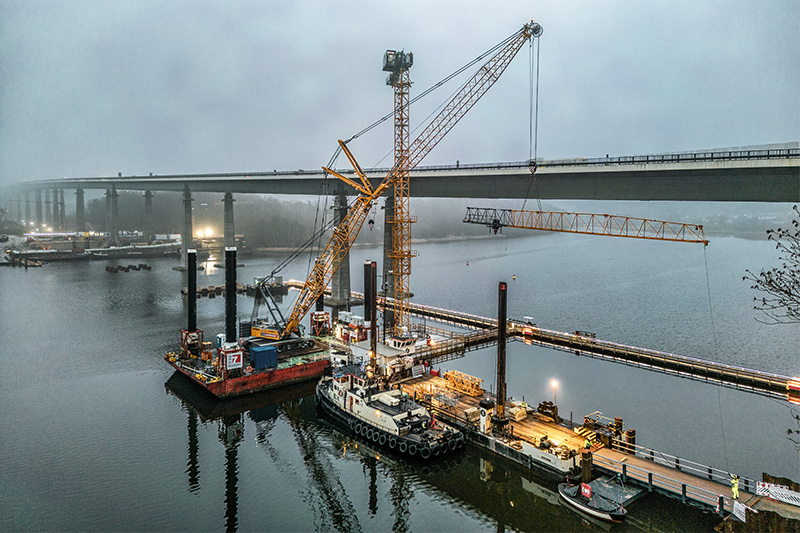18 Liebherr cranes are engaged in a project to replace Germany’s second longest steel road bridge.
The Rader High Bridge spans the Kiel Canal along the A7 motorway, the northbound high-speed link from Hamburg to Denmark. The bridge is to be replaced and widened over the next few years.
The 18 Liebherr cranes, ranging from the 65 K.1 to the 150 EC-B, are tasked with the lifting work and some have been erected in the water.
The bridge, built in 1972, measures just under 1,500 metres in length. It is approaching the end of its useful life as a result of high volumes of traffic.
The cranes belong to the rental fleet of Friedrich Niemann GmbH & Co. KG, based in Kronshagen. Five fast-erecting cranes, two 65 K.1s and three 81 K.1s, are on site to assist with the foundations. The new bridge piers are being built with the help of six 125 EC-B and seven 150 EC-B flat-top cranes.
The first crane to arrive, a 125 EC-B, was assembled at the end of 2023. Assembly took place in the waters of Lake Borgstedt, where the crane stood on the first pier’s pile cap secured by foundation anchors. This involved working with a Liebherr crawler crane from Nenzing (Austria).
The 250-tonne LR 1250 crawler crane required for the assembly was positioned on a floating platform between the crane site and a ferry used for transporting parts. The flat-top crane reached a hook height of 44 metres. Three 125 EC-B cranes were also assembled using the 250-tonne crawler from its floating platform. The cranes were initially assembled at a height of 30 metres and then climbed to their final hook height of 50 metres using hydraulic climbing equipment.
A 150 EC-B 8 Litronic started off working on the bridge pier on land. Liebherr explained that the progression of the site required the crane to be moved to a new location. At the end of June 2024 it was time for the flat-top crane to move from the north side of the bridge to the next bridge column and reassembled in the water. The disassembled crane was transported on a ferry and put back together. Once assembled, it climbed to a hook height of around 50 metres and reached a jib length of 40 metres. The crane has the capacity to lift up to eight tonnes.
The build is happening in two stages with traffic flowing along the existing bridge as well as the Kiel Canal. The eastern half of the bridge is being built first, next to the existing bridge, and is expected to be opened to traffic in 2026. Following this, the original bridge will close and be demolished, with the western bridge section being built in its place. The new structure is being widened to six lanes and should be finished in 2031.











